STUDYING ON THE EXPRESSION LEVEL OF A20 IN PATIENTS WITH NON-HODGKIN LYMPHOMA
Main Article Content
Abstract
Objective: Determine the mRNA expression level of A20 in NHL patients. Evaluate the relationship between mRNA expression level of A20 and some clinical, subclinical characteristics in NHL patients. Methods: 83 patients were diagnosed with NHL and 83 healthy people as a control group. Quantitative RT-PCR was used to analyze mRNA expression of A20. Results: The average age of the NHL patient group was 56.4 ± 16.1 years. The highest age is 86 years old, the lowest age is 17 years old. The percentage of age group ≤ 60 and over 60 is 51.8% and 48.2%, respectively. Stage (I and II) is 41% and 59% is stage (III and IV). Aggressive lymphoma group account for 84.3% and only 15.7% in indolent group. The mRNA expression level of A20 in the NHL patient group is lower than the control group with P < 0.05. The mRNA expression level of A20 is moderately negatively correlated with β2-Microglobulin concentration with statistical significance (rs= -0.31, p = 0.005).There is no statistically significant in the mRNA expression level of A20 with age, stage, progression group and some subclinical characteristics in patients with NHL. Conclusion: The mRNA expression level of A20 in the NHL patient group is lower than the control group and moderately inversely correlated with β2-Microglobulin concentration, has statistically significant. There is no statistically significant relationship between the mRNA expression level of A20 and some clinical, subclinical in NHL patients.
Article Details
Keywords
Non-Hodgkin lymphoma, CYLD expression level.
References
2. Honma K., et al. (2009). TNFAIP3/A20 functions as a novel tumor suppressor gene in several subtypes of non-Hodgkin lymphomas. Blood, The Journal of the American Society of Hematology. 114(12): p. 2467-2475.
3. Wang X., et al. (2014). Abnormal expression of A20 and its regulated genes in peripheral blood from patients with lymphomas. Cancer cell international. 14(1): p.1-6.
4. Shi L., et al. (2013). Changes in the MALT1-A20-NF-κB expression pattern may be related to T cell dysfunction in AML. Cancer cell international. 13(1): p. 1-6.
5. Ma Y., et al. (2014). Characteristics of CARMA1-BCL10-MALT1-A20-NF-κB expression in T cell-acute lymphocytic leukemia. European journal of medical research. 19(1): p. 1-6.
6. Yoon C.I., et al. (2012). High A20 expression negatively impacts survival in patients with breast cancer. PloS one. 14(8): p. e0221721.
7. Wang Q., et al. (2012). Expression of A20 is reduced in pancreatic cancer tissues. Journal of molecular histology. 43: p. 319-325.


